Forearm stretches are great to do if your forearm feels tight because they help to loosen up your muscles by getting rid of lactic acid and toxins. They’re also more comfortable to perform than a protocol like forearm myofascial release, which can be quite painful for some people. Plus, it requires additional equipment that not all of us have.
In this complete forearm stretch guide, I’ll show you first how to stretch your forearm safely so that you don’t get injured. Then, I’ll give you my rundown of the top forearm stretches for flexibility, sore muscles, and general health.
Related post: forearm pain from fibromyalgia
How to stretch your forearm

Here’s how to stretch forearm muscles the right way. Essentially, you first want to hold each stretch for a short duration (10 seconds) before increasing the time under tension to 20-30 seconds.
This is because 10 seconds is enough time for you to gauge your current flexibility, but not so much time that you’ll injure yourself if you don’t yet have the necessary suppleness to do a particular forearm stretch.
Also, make sure that you never exaggerate these wrist and forearm stretches that I’m about to show you. It’s not a case of “the more intense and painful, the better” when it comes to any kind of stretches for forearm muscles.
Instead, you want to stretch the muscle belly enough to feel an effect, but not so much that you struggle to hold the position for 20-30 seconds, which we’ll progress to from the initial 10-second stretch.
Finally, be wary of moving into stretches too soon if you have a strained forearm or other problems like forearm cramps. If you stretch the forearm prematurely during your recovery, you could actually stunt the healing process.
Best forearm stretches
I’ve tried and analyzed the movement patterns of some of the top forearm stretches out there to see which provide the best effects.
1. Forearm extensor stretch
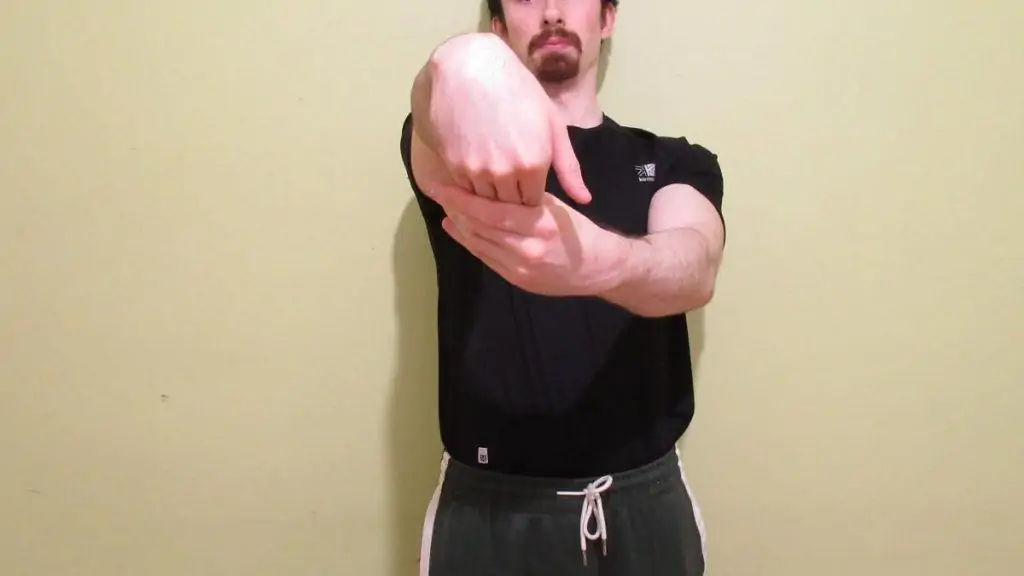
This simple yet effective forearm extensor stretch is at the top of the list because the wrist extensors are an area that many people overlook. If you spend a lot of time on touch screen devices, then this stretch will provide particularly strong relief from discomfort because the loosening of these muscles will be quite a novel stimulus.
- Raise your arms out in front of you, elbows fully locked out.
- Bend the palm of one hand so that your knuckles are facing away from you.
- Then, with your other hand, gently pull the fingers of your “working hand” towards you.
- Hold this stretch for 15-30 seconds, and then move onto your other arm.
Read more: weightlifting and forearm pain │forearm hurts when curling
2. Forearm flexor stretch
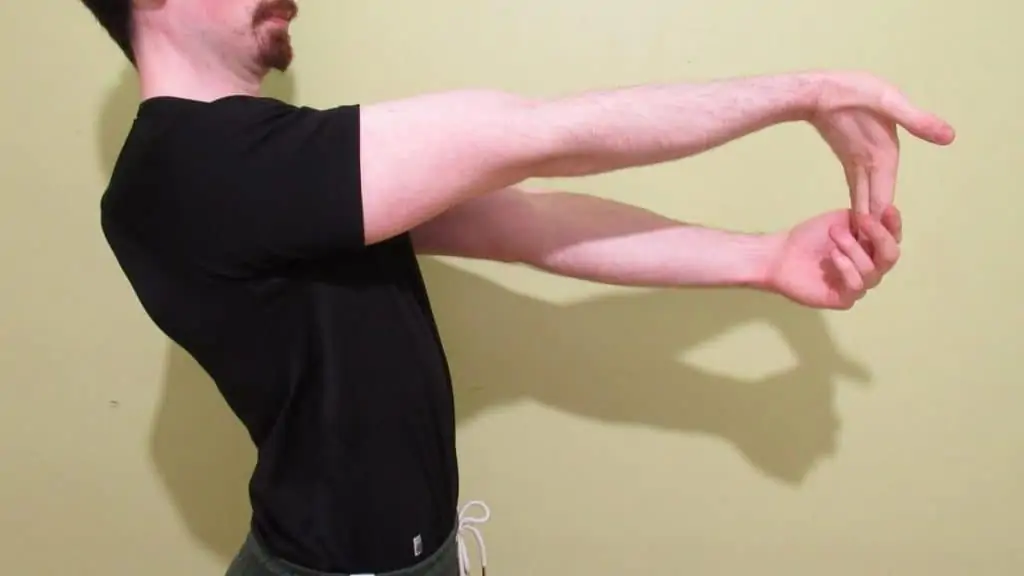
The underside of the forearm (the flexor) is heavily worked during many different exercises and activities. As such, this proven forearm flexor stretch takes the second spot on our list because it’s an area that can become tight for many people.
Those who have forearm splints from lifting can also experience pain relief from performing this movement.
Additionally, there are many variations of the forearm flexor stretch that involve different body positions. For example, some people recommend placing your hands on the floor and then bending your wrists to stretch the flexors.
However, all of these variations stretch the exact same muscles. People like to overcomplicate forearm stretches so that they can seem like an innovator, but really, it’s a case of the simpler, the better. This is because when the stretch is straightforward, you can focus purely on the muscle in question and not on some arbitrary torso or leg position.
- Stand up and place both arms out in front of you with your elbows locked out.
- Raise the palm of one hand up as if you’re waving to a friend.
- Then, with your other hand, gently pull your fingers towards you.
- Hold this position for 15-30 seconds and then repeat for the other arm.
3. Supinator stretch
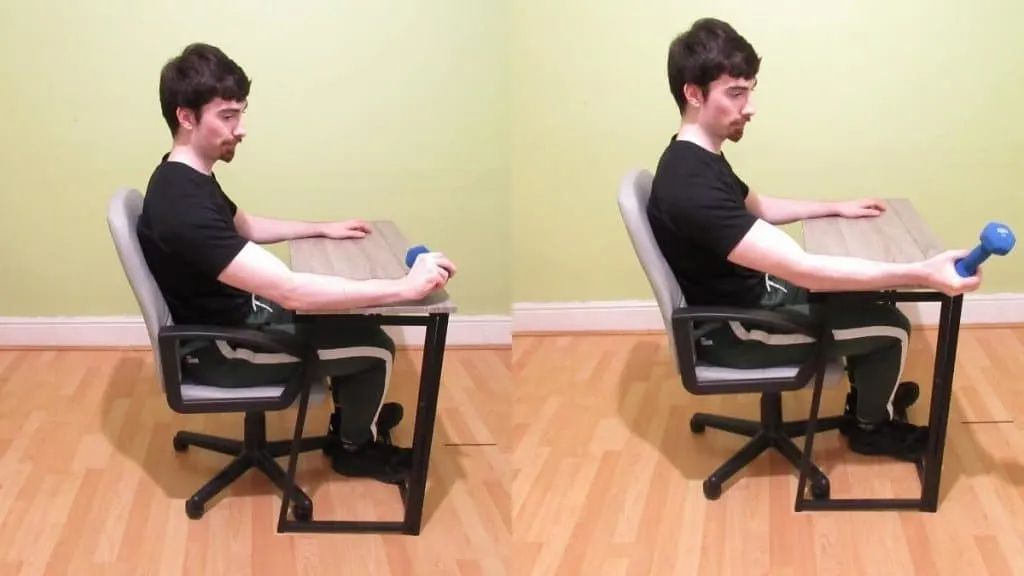
When people eventually learn how to stretch forearms properly, whether their own lower arms or even those of their clients, they invariably forget that the wrists are also responsible for pronation and supination of the lower arm.
This supinator stretch requires a dumbbell, but it’s very straightforward to execute. It also stretches the key supinating muscles of the lower arm by applying a nice weighted stretch.
Not that you can also have someone apply manual pressure on your arm while it’s in the correct position (see the text below or the picture above) if you don’t have access to weights.
Also, see our popular guide for more forearm rehabilitation drills if you want to build lower arm strength via weight training.
- Hold one end of a light dumbbell in your hand and then rest that arm, palm down, on a flat surface.
- Allow the dumbbell to rotate your hand just beyond neutral.
- Hold this position for 15-30 seconds and make sure to keep the weight light.
4. Two-arm forearm stretch

Unlike the other stretches for forearms, this drill relieves tightness in the brachioradialis, which is one of the major muscles on the top (the posterior compartment) of your forearm. It’s particularly useful if you have pain in your brachioradialis because not even weight training can effectively stretch this overlooked muscle to such a tension relieving degree.
Of course, you can also do this drill to stretch your flexors by locking your elbows out and facing your palms away from you.
See also: forearm muscle pain while doing pull ups
- Place your hands out in front of you, elbows locked out, and then internally rotate your shoulders so that the backs of your hands are facing each other.
- Place one hand over the other and interlock all of your fingers. The arm on top is the one that we’re going to stretch.
- Rotate your arms in the opposite direction of the arm that’s being stretched.
- Then, with your non-working arm, push the wrist of your stretched arm into flexion.
- Hold this position for 15-30 seconds and then repeat for your other arm by switching that to the top position.
Although it sounds a bit confusing, this is easily one of the best forearm stretches out there because it takes the lower arms out of the flexed position that they’re in for most of the day when we’re typing on the keyboard or using our phones (our typing forearm pain article has more info on this).
5. Praying forearm stretch
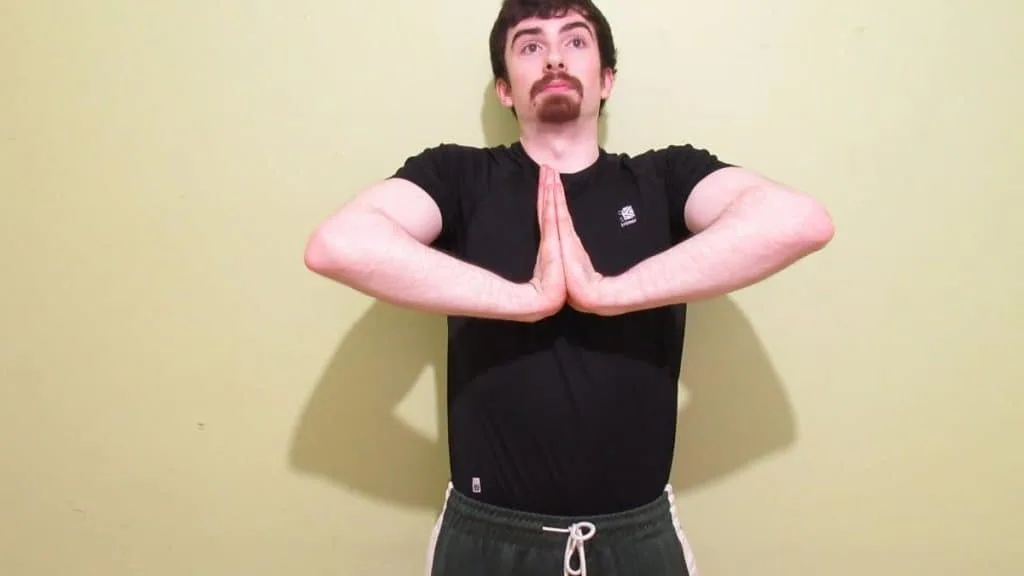
The unfortunate thing about most forearm and wrist stretches [1] is that you need to stretch both limbs independently. This makes your stretching routine take longer, and people often forget to stretch their other arm, which leads to disparities in flexibility.
The positioning of this drill makes the praying stretch one of the top tight forearm muscles stretches because you can do it anywhere and get great tension relief in a fraction of the usual time.
- Stand up straight or sit upright in a chair.
- Place the palms of your hands together without interlocking your fingers.
- Raise both elbows so that your wrists begin to bend
- Keep raising your elbows until you feel a nice stretch in the undersides of your forearms.
- Hold it for 15-30 seconds.
Read more: pain in your wrist and forearm when gripping │gaming forearm pain
Benefits of performing forearm stretches
When you stretch forearm muscles on other people or show them how to do it for themselves, they often remark at how supple they feel. But, as you’ll soon learn, there are more benefits to stretching than enhanced flexibility.
Improved blood flow
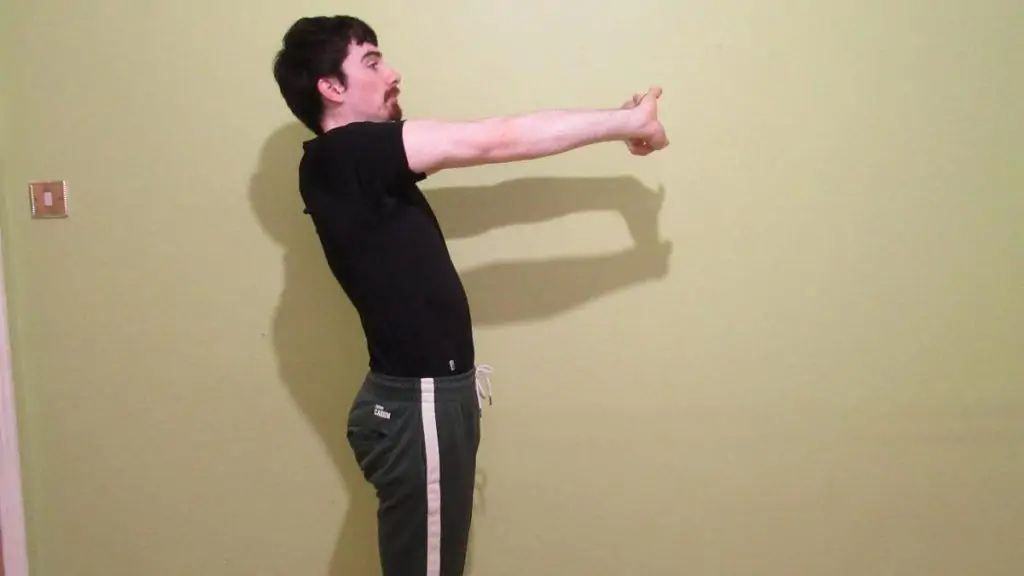
Forearm muscle stretches are useful if you have sore muscles because they improve blood flow, which in turn helps your damaged connective tissue to heal faster. [2]
Stretching does this by reducing the amount of toxins and lactic acid in the bloodstream. Ultimately, this reduces delayed onset muscle soreness (DOMS) as well.
Enhances your range of motion

Having an extensive range of motion (ROM) helps you get a better workout because you can put the muscles under more tension. [3]
However, it simultaneously makes you more resistant to injuries because you’re training your muscles to become more resistant to weighted stretches, which are a critical component of resistance training and the part of a rep in which most injuries occur.
Better posture
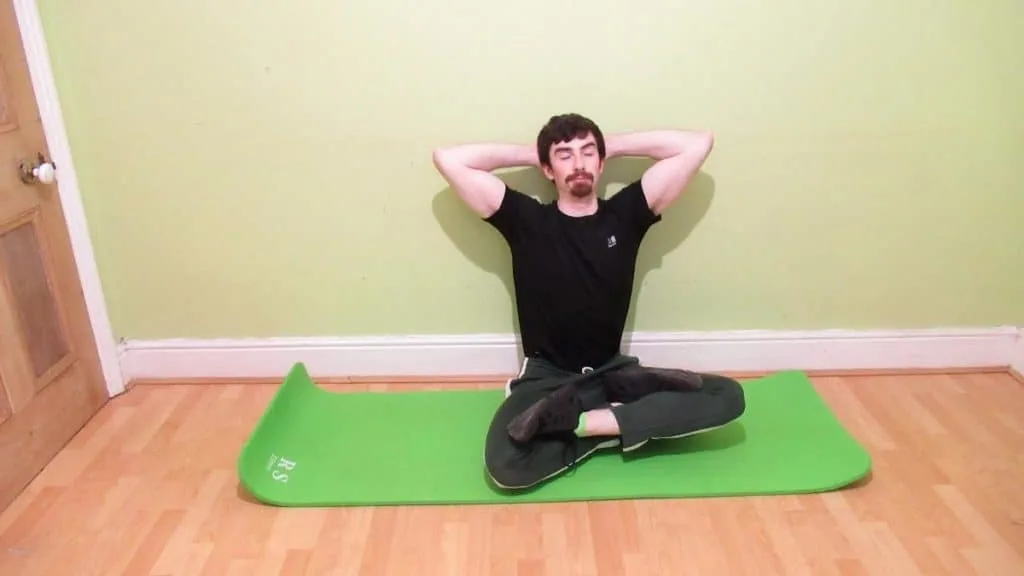
Poor posture is an all too common side effect of our modern lives. And it’s not like 5 minutes of stretching on your lunch break will fix this bad habit.
However, research does show that stretching can improve your posture because it subjects the muscles to tension and makes them more adept at handling resistance.
This, in turn, means that your muscles can better support your body weight in various positions, which is exactly what good posture is.
Reduced stress
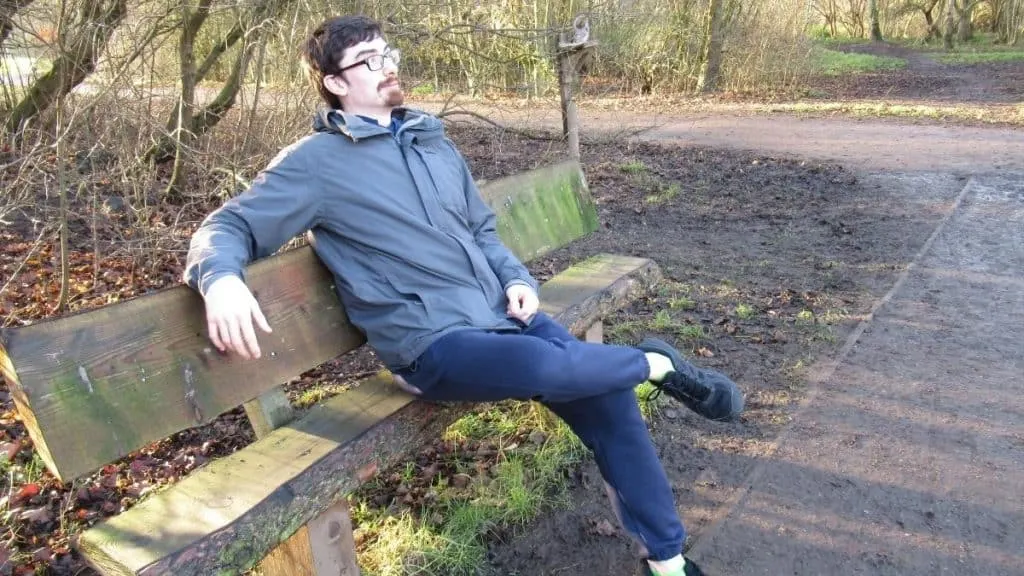
Sore forearm stretches not only reduce DOMS, but they also reduce stress too. When you stretch your forearms, you simultaneously relieve your body of tension, which can quickly build up from emotional stress triggered by work and personal events.
This stress reduction can leave you feeling cheerful and optimistic about the world rather than uptight and anxious.
More energy
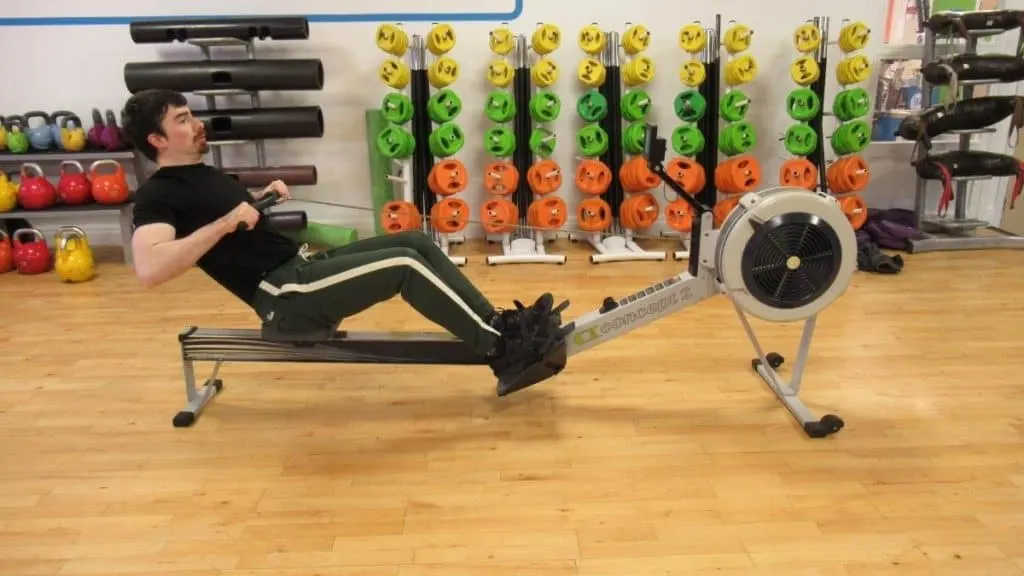
There are many forearm stretches for tendonitis and other conditions that can help injuries heal faster by promoting blood flow to damaged muscle tissue. But did you know that this increased blood flow can also increase whole body energy levels?
When you’re sat down, blood pools into certain body parts and makes you feel lethargic. But once the blood gets pumping around your body as a result of your stretching, you’ll feel a sense of invigoration and have more energy to go about your daily tasks.
A quick summary on forearm stretches
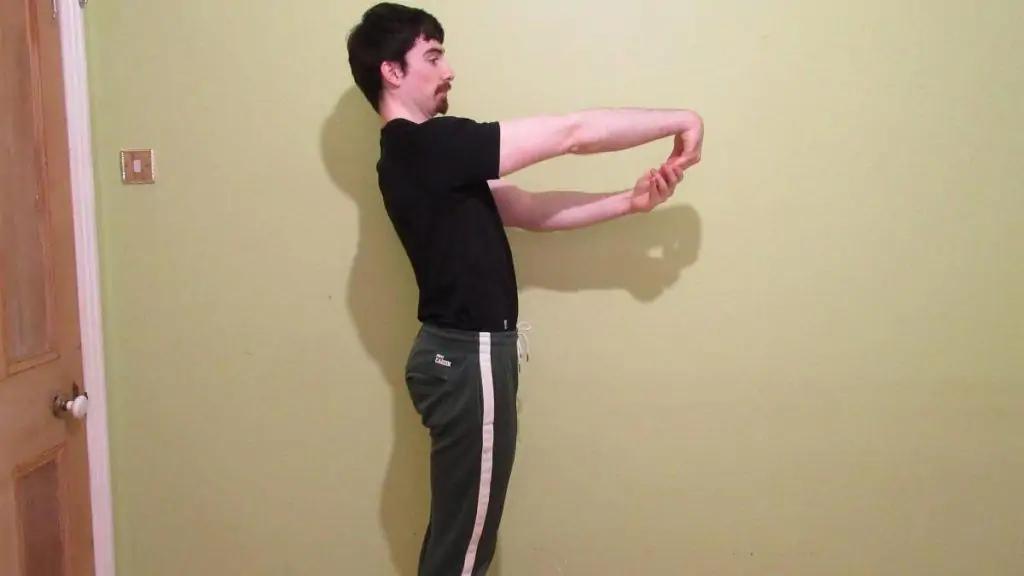
Whether you’re an athlete, a person in rehab, or just someone wanting more flexibility and pain relief, forearm stretches can help. Not only are they easy to perform, but they can make our lives more bearable by reducing tightness that all too often occurs from activities like typing, phone usage, and weight lifting.
When learning how to stretch your forearm for the first time, there are a few key things to remember. First, seek tension, not pain. You should certainly feel your forearm being stretched, but it shouldn’t be to the point of intense discomfort.
Also, don’t hold the forearm stretch for longer than 30 seconds unless your physical therapist has told you to. This way, you relieve tightness without putting too much tension through the muscle and potentially giving yourself a sprain.
References
- Sutton, D., Gross, D. P., Côté, P., Randhawa, K., Yu, H., Wong, J. J., Stern, P., Varatharajan, S., Southerst, D., Shearer, H. M., Stupar, M., Goldgrub, R., van der Velde, G., Nordin, M., Carroll, L. J., & Taylor-Vaisey, A. (2016). Multimodal care for the management of musculoskeletal disorders of the elbow, forearm, wrist and hand: a systematic review by the Ontario Protocol for Traffic Injury Management (OPTIMa) Collaboration. Chiropractic & Manual Therapies, 24(1). https://doi.org/10.1186/s12998-016-0089-8
- Hotta, K., Behnke, B. J., Arjmandi, B., Ghosh, P., Chen, B., Brooks, R., Maraj, J. J., Elam, M. L., Maher, P., Kurien, D., Churchill, A., Sepulveda, J. L., Kabolowsky, M. B., Christou, D. D., & Muller-Delp, J. M. (2018). Daily muscle stretching enhances blood flow, endothelial function, capillarity, vascular volume and connectivity in aged skeletal muscle. The Journal of Physiology, 596(10), 1903–1917. https://doi.org/10.1113/jp275459
- Iwata, M., Yamamoto, A., Matsuo, S., Hatano, G., Miyazaki, M., Fukaya, T., Fujiwara, M., Asai, Y., & Suzuk, S. (2019). Dynamic Stretching Has Sustained Effects on Range of Motion and Passive Stiffness of the Hamstring Muscles. Journal of Sports Sciences and Medicine, 18(1), 13–20. https://www.ncbi.nlm.nih.gov/pmc/articles/PMC6370952/
- Bob & Brad. (2019, April 30). BEST Wrist Forearm Stretches to Release Tightness and Pain- Beginner to Advanced [Video]. YouTube. https://www.youtube.com/watch?v=ko5Kbb2PTEs

